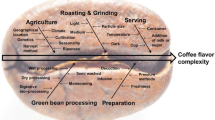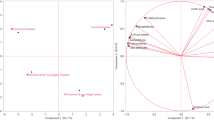Abstract
The mechanisms of volatile release from soluble coffee powders with different roasting degrees were studied. The presence of volatiles in the headspace during coffee humidification was analyzed by gas chromatography. Small amounts of volatiles were observed at low water activities (a w), independently from the roasting degree; as the a w increased headspace volatiles rose and then decreased as the moisture further increased. The changes in aw and volatiles went along with the changes of coffee structure from a free-flowing powder to a sticky viscous fluid. The mechanism of volatiles release was controlled by both kinetic and thermodynamic factors. The former prevailed at low a w in glassy systems; while the latter became important at high a w when, due to increased mobility, equilibrium conditions were approached. Modified state diagrams were used to predict the critical temperature and a w at which structural collapse and volatile release occurred. As far as equilibrium condition was achieved, coffee volatiles were partially re-adsorbed in the liquid phase.





Similar content being viewed by others
References
Lubbers S, Landy P, Voilley A (1998) Food Technol 52(5):68–74, 208–214
Druaux C, Voilley A (1997) Trends Food Sci Technol 8:364–368
Hofmann T, Czeny M, Calligaris S, Schieberle P (2001) J Agric Food Chem 49:2382–2386
Lopes da Silva JA, Castro SM, Delgadillo I. (2002) J Agric Food Chem 50:1976–1984
Goubet I, Le Quere J-L, Voilley AJ (1998) J Agric Food Chem 46:1981–1990
Flink J, Karel M (1970) J Agric Food Chem 18:295–297
Flink J, Karel M (1972) J Food Technol 7:199–211
Flink J, Gejl-Hansen F (1972) J Agric Food Chem 20:691–694
Gunning YM, Gunning PA, Kemsley EK, Parker R, Ring SG, Wilson RH, Blake A (1999) J Agric Food Chem 47:5198–5205
Rifa MK, Voilley A (1991) J Food Sci Technol 28:135–137
Lerici CR (1976) Rivista Scientifica di Tecnologia, Alimentazione e Nutrizione Umana 6:27–31
Aguilera JM (2000) Structure-properties relationships in foods. In: Lozano L, Anon C, Parada E, Barbosa G (eds) Trends in Food Engineering. Technomics, Lancaster, PA, pp 1–14
Blake A (1994) Int Food Ingredient 3:30–34
Omatete OO, King CJ (1978) J Food Technol 13:265–280
Rosenberg M, Kopelman IJ, Talmon Y (1990) J Agri Food Chem 38:1288–1294
Thijssen HAC (1971) J Appl Chem Biotechnol 21:372–377
Voilley A (1995) Flavor encapsulation. Influence of encapsulation media on aroma retention during drying. In: Risch SJ, Reineccius GA (eds) Encapsulation and Controlled Release of Food Ingredients. American Chemical Society, Washington, DC, pp 169–179
Whorton C (1995) Factors affecting volatile release from encapsulation matrices. In: Risch SJ, Reineccius GA (eds) Encapsulation and Controlled Release of Food Ingredients. American Chemical Society, Washington, DC, pp 134–142
Chirife J, Karel M, Flink J (1973) J Food Sci 38:671–674
Flink J (1975) The retention of volatile components during freeze-drying: a structurally based mechanism. In: Goldblith SA, Rey L, Rothmayr WW (eds) Freeze Drying and Advanced Food Technology. Academic Press Inc., London, pp 79–88
To EC, Flink JM (1978) J Food Technol 13:567–581
To EC, Flink JM (1978) J Food Technol 13:583–594
Levine H, Slade L (1986) Carb Polym 6:213–244
Levine H, Slade L (1988) Cryo-Lett 9:21–63
Labrousse S, Roos Y, Karel M (1992) Science des Aliments 12:757–769
Levi G, Karel M (1995) J Food Eng 24:1–13
Shimada Y, Roos Y, Karel M (1991) J Agric Food Chem 39:637–641
Whorton C, Reineccius GA (1995) Evaluation of the mechanisms associated with the release of encapsulatated flavor from maltodextrin matrices. In: Risch SJ, Reineccius GA (eds) Encapsulation and Controlled Release of Food Ingredients. American Chemical Society, Washington, DC, pp 143–160
Lerici CR, Nicoli MC, Manzocco L (1996) Industrie Alimentari 35:13–13
AOAC (1995) Official Methods of Analysis 16th ed. Associations of Official Analytical Chemists International, Arlington, VA. Chap.42
Gal S (1975) Recent advances in techniques for the determination of sorption isotherms. In: Duckworth RB (ed) Water Relations in Foods. Academic Press, London, pp 139–154
SAS (1999) JMP 3.2.5. SAS Institute Inc., Cary, NC
Gordon M, Taylor JS (1952) J Appl Chem 2:493–500
Johari GP, Hallbrucker A, Mayer E (1987) Nature 330:552–553
Grosh W (2001) Chemistry III: volatile compounds. In: Clarke RJ, Vitzthum OG (eds) Coffee Recent Developments. Blackwell Science Ltd., Oxford, UK, pp 68–89
Peleg M (1983) Physical characteristic of food powders. In: Peleg M, Bagley EB (eds) Physical Properties of Foods. AVI Publishing Company Inc., Westport, CT, pp 293–323
Tsourouflis S, Flink JM, Karel M (1976) J Sci Food Agric 27:509–519
Levi G, Karel M (1995) Food Res Int 28:145–151
Roos YH (1995) Phase Transitions in Foods. Academic Press, New York
Acknowledgements
Nestlè Research Centre of Lausanne is thanked for providing the coffee samples
Author information
Authors and Affiliations
Corresponding author
Rights and permissions
About this article
Cite this article
Anese, M., Manzocco, L. & Maltini, E. Effect of coffee physical structure on volatile release. Eur Food Res Technol 221, 434–438 (2005). https://doi.org/10.1007/s00217-005-1196-2
Received:
Revised:
Published:
Issue Date:
DOI: https://doi.org/10.1007/s00217-005-1196-2




